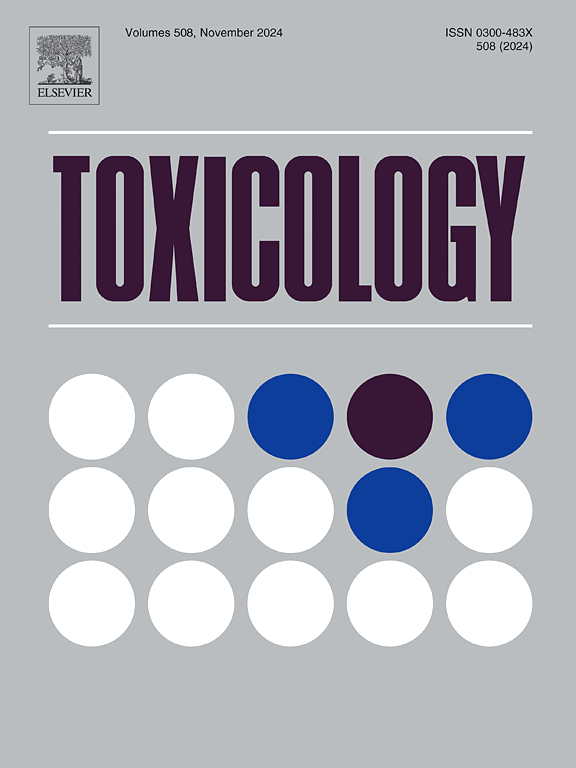Mechanisms involved in pro-inflammatory responses to traffic-derived particulate matter (PM) in THP-1 macrophages compared to HBEC3-KT bronchial epithelial cells
IF 4.6
3区 医学
Q1 PHARMACOLOGY & PHARMACY
引用次数: 0
Abstract
The pro-inflammatory responses in THP-1-derived macrophages and human bronchial epithelial cells (HBEC3-KT) were examined after exposure to size-fractioned particulate matter (PM) sampled in two road tunnels. All tunnel PM samples induced release and expression of CXCL8 and IL-1β in THP-1 macrophages (50 µg/mL) and HBEC3-KT cells (100 µg/mL), but the potency of the samples differed between the cell types. The road tunnel PM induced pro-inflammatory responses in the macrophages to a much higher extent than diesel exhaust particles (DEP) and particles derived from the stone materials used in the asphalt. Tunnel PM induced a markedly higher increase in cytochrome P450 (CYP)1A1 expression in HBEC3-KT cells than in THP-1 macrophages. The content of organic carbon (OC) in PM correlated to the release of CXCL8 in HBEC3-KT cells, but not in THP-1 macrophages. Moreover, the aryl hydrocarbon receptor (AhR)-inhibitor CH223191 and the antioxidant N-acetyl cysteine (NAC) reduced the PM-induced cytokine release in the macrophages to a lower extent than in HBEC3-KT. In contrast, a toll-like receptor (TLR)2 antibody markedly reduced the PM-induced responses in THP-1 macrophages, but not in HBEC3-KT. A TLR4 antibody was without effect in both cell types. The levels of the microbial TLR2-ligand β-glucan in the PM samples were in a range that might be sufficient to induce pro-inflammatory responses. However, a microbial-independent mechanism could also be involved. In support of such a mechanism, the pro-inflammatory responses to a sample of α-quartz (Min-U-Sil 5), with low levels of β-glucan, were reduced by anti-TLR2. In conclusion, our results indicate that traffic-derived PM exert pro-inflammatory responses in THP-1 macrophages and HBEC3-KT cells via different PM constituents and mechanisms. OC/AhR-dependent mechanisms appeared to be important for PM-induced CXCL8 responses in HBEC3-KT cells, while the cytokine responses in THP-1 macrophages seemed to involve TLR2-mediated activation, either via β-glucan-dependent or -independent mechanisms.
THP-1巨噬细胞对交通来源颗粒物(PM)的促炎反应机制与HBEC3-KT支气管上皮细胞的比较
在两条公路隧道中,研究了thp -1来源的巨噬细胞和人支气管上皮细胞(HBEC3-KT)暴露于粒径分异颗粒物(PM)后的促炎反应。所有隧道PM样品均诱导THP-1巨噬细胞(50 µg/mL)和HBEC3-KT细胞(100 µg/mL)中CXCL8和IL-1β的释放和表达,但样品的效力因细胞类型而异。公路隧道PM诱导巨噬细胞的促炎反应程度远高于柴油尾气颗粒(DEP)和沥青中使用的石料颗粒。隧道PM诱导细胞色素P450 (CYP)1A1在HBEC3-KT细胞中的表达明显高于THP-1巨噬细胞。在HBEC3-KT细胞中,PM中有机碳(OC)含量与CXCL8的释放相关,而在THP-1巨噬细胞中不相关。此外,芳烃受体(AhR)抑制剂CH223191和抗氧化剂n -乙酰半胱氨酸(NAC)对pm诱导的巨噬细胞细胞因子释放的抑制程度低于HBEC3-KT。相比之下,toll样受体(TLR)2抗体在THP-1巨噬细胞中显著降低pm诱导的反应,但在HBEC3-KT中没有。TLR4抗体在两种细胞类型中均无作用。PM样品中微生物tlr2配体β-葡聚糖的水平在一个可能足以诱导促炎反应的范围内。然而,一种与微生物无关的机制也可能参与其中。为了支持这一机制,在β-葡聚糖水平较低的α-石英(Min-U-Sil 5)样品中,抗tlr2可以降低促炎反应。总之,我们的研究结果表明,交通来源的PM通过不同的PM成分和机制在THP-1巨噬细胞和HBEC3-KT细胞中发挥促炎反应。OC/ ahr依赖性机制似乎对pm诱导的HBEC3-KT细胞中的CXCL8反应很重要,而THP-1巨噬细胞中的细胞因子反应似乎涉及tlr2介导的激活,通过β-葡聚糖依赖性或非依赖性机制。
本文章由计算机程序翻译,如有差异,请以英文原文为准。
求助全文
约1分钟内获得全文
求助全文
来源期刊

Toxicology
医学-毒理学
CiteScore
7.80
自引率
4.40%
发文量
222
审稿时长
23 days
期刊介绍:
Toxicology is an international, peer-reviewed journal that publishes only the highest quality original scientific research and critical reviews describing hypothesis-based investigations into mechanisms of toxicity associated with exposures to xenobiotic chemicals, particularly as it relates to human health. In this respect "mechanisms" is defined on both the macro (e.g. physiological, biological, kinetic, species, sex, etc.) and molecular (genomic, transcriptomic, metabolic, etc.) scale. Emphasis is placed on findings that identify novel hazards and that can be extrapolated to exposures and mechanisms that are relevant to estimating human risk. Toxicology also publishes brief communications, personal commentaries and opinion articles, as well as concise expert reviews on contemporary topics. All research and review articles published in Toxicology are subject to rigorous peer review. Authors are asked to contact the Editor-in-Chief prior to submitting review articles or commentaries for consideration for publication in Toxicology.
 求助内容:
求助内容: 应助结果提醒方式:
应助结果提醒方式:


